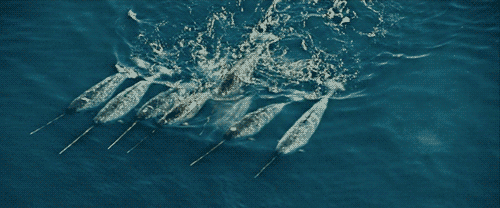An unprecedented sight of the sea monster
Experts have recently discovered a strange "mission" in the narwhal ivory. You know, what are they allowed to do?
Narwhale (narwhale) is a marine creature whose relatives are close to white whales. They live in the Arctic waters so rare people know. Whoever caught the narwhal will be impressed by the ivory - developed from their left fangs.
It is known that ivory is the place where many blood vessels and nerves are gathered, so that narwhal can feel different surfaces when colliding.
 The new "use" of narwhal tusks - is to use ivory to hunt cod.
The new "use" of narwhal tusks - is to use ivory to hunt cod.
However, the most recent footage recorded from drones in Tremblay Sound, Nunavat, East North Canada shows "new use" for narwhal tusks - that is to use ivory to hunt cod. .
This act of fishing ivory may be a explanation for decades of biological mystery: "Why does this creature have a long left canine that extends through the upper lip and protrudes from this creature? from the beginning like a unicorn's horn? What is the function and mission of this ivory? "

Close-up of the strange horn of narwhal.
Brandon Laforest, a senior expert on species and arctic ecosystems, said: "This is a completely new observation of how horns are used."
This "spooky" ivory that can grow up to 2.7 meters in length also poses numerous questions for scientists.
Such questions include how to occupy partners, the ability to locate echoes or use in battles with other creatures.

The "ghost" ivory can increase its length to 2.7m.
At the end of last year, researchers discovered that the ivory helped the narwhal to locate the direction by sound. Because the ivory section does not have a hard enamel coating, the seawater will pass through the hole on the ivory surface, through the main axis and stimulate the nerve at the end of the tooth, near the head, thereby sending signals to the brain.
This will help the narwhal feel the sound even at the smallest intensity.
It is known that this is the first time we witnessed the "magic" tusks used for hunting. Perhaps that is the final piece of the strange evolution of nature in this marine species.
- 10 most famous aquatic monsters of all time
- The video shows an unprecedented deep freak monster
- Mysterious skinhead monster in Japanese legend
- A witness turned the Loch Ness monster
- Loch Ness monster monster objects head up on the lake
- Decode the phenomenon of
- The most convincing picture of the Loch Ness monster
- Headless skeleton of 6 meter long sea monster
- Video: The image is said to be Loch Ness monster
- The constant debate about the 300 million-year-old Tully monster
- 'Secret' about the late Man and the Love of the work at first sight
- Legend of the 'water monster' Da river
 Surprised: Fish that live in the dark ocean still see colors
Surprised: Fish that live in the dark ocean still see colors Japan suddenly caught the creature that caused the earthquake in the legend
Japan suddenly caught the creature that caused the earthquake in the legend A series of gray whale carcasses washed ashore on California's coast
A series of gray whale carcasses washed ashore on California's coast Compare the size of shark species in the world
Compare the size of shark species in the world